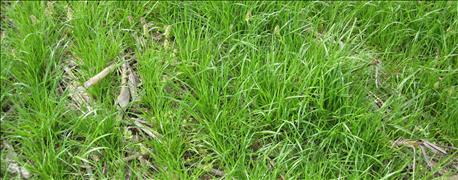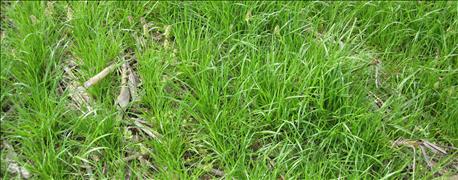
Annual ryegrass is very deep rooting. Don Donovan, a district conservationist with the Natural Resources Conservation Service, says it scavenges leftover soil nitrogen and provides excellent erosion control. These attributes make annual ryegrass an excellent cover crop, but a well-thought-out termination plan is essential.
Farmers throughout Indiana who use annual ryegrass say they can overcome these challenges with proper management and planning. Donovan works with several farmers who have found a “recipe” for successful annual ryegrass termination.

FOLLOW RECIPE: Failure to follow any one part of the recipe successful cover croppers use to terminate annual ryegrass can result in disaster. (Photo courtesy of Kris Vance, NRCS.)
Other members of the NRCS team and the Indiana Conservation Partnership contributed to this information. Here are the key ingredients to terminating annual ryegrass.
Patience, patience, patience
The first ingredient is a "double extra measure of patience," Donovan emphasizes. Weather conditions must be appropriate for terminating ryegrass. That generally means at least three consecutive days with temperatures over 50 degrees F and no nights with temperatures under 30 degrees.
A general rule of thumb is: Don’t spray your ryegrass until you have mowed your lawn a couple of times. Ryegrass has to be actively growing to be successfully terminated; therefore, it must be warm. Farmers find that if they load up the sprayer and head out to terminate ryegrass on the first warm day of the spring, they will regret it, the conservationist stresses.
Timing is the next ingredient. Annual ryegrass wakes up late in the morning and goes to bed early in the evening. Your herbicide must be applied while the plant is actively growing so it will translocate down the 40-inch-deep roots. The translocation process can take three hours, so a “10 to 2” spray window has been found to work best for most of Indiana. That means spraying between 10 a.m. and 2 p.m.
Spray water is one of the main ingredients of this recipe. Do you or your retailer check the quality of the water used with your herbicides? Follow the label, but herbicides used to terminate annual ryegrass are typically more effective at lower pH levels. Check with your local retailer about products to lower the pH of your spray water to levels recommended on the product label.
Hard water
As important as pH is the hardness of spray water. In many places in Indiana, groundwater has a high hardness level due to the high calcium in the bedrock where wells are located. Get your water tested, and use appropriate products to adjust the hardness to levels recommended on the termination product’s label.
Adjust the pH and hardness of your spray water before you add the herbicide. Never add the herbicide before adding products to correct the water.
The final ingredient is knowledge. Do your research, whether by going online, going to field days and conferences, or finding a local successful farmer who uses annual ryegrass as a cover crop. Annual ryegrass can provide some incredible benefits for your soil, but at the same time, it can provide some challenges, Donovan says. Seek out someone who has made it work and talk to him or her — but more importantly, listen to that person, he urges.
Here's more information on the use of annual ryegrass as a cover crop and successful termination. Check out Purdue University’s website for spray water quality information.
About the Author(s)
You May Also Like




